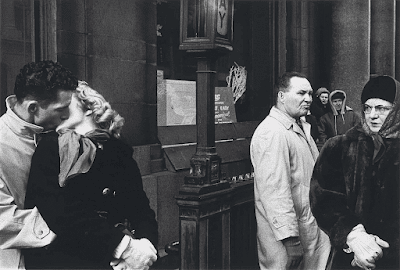 |
| Eikoh Hosoe Ordeal by Roses no. 32 (Yukio Mishima) 1961 gelatin silver print Victoria & Albert Museum, London |
 |
| Ray Metzker Valencia 1961 gelatin silver print Nelson-Atkins Museum of Art, Kansas City, Missouri |
 |
| Ray Metzker Philadelphia 1963 gelatin silver print Nelson-Atkins Museum of Art, Kansas City, Missouri |
 |
| Ray Metzker 63-E-8-Phila 1963 gelatin silver print Nelson-Atkins Museum of Art, Kansas City, Missouri |
 |
| Robert Brownjohn Servants 1961 gelatin silver print Victoria & Albert Museum, London |
 |
| Robert Brownjohn Smoke Extract 1961 gelatin silver print Victoria & Albert Museum, London |
 |
| Robert Brownjohn Tradesmen's Entrance 1961 gelatin silver print Victoria & Albert Museum, London |
 |
| Robert Brownjohn Twinlock 1961 gelatin silver print Victoria & Albert Museum, London |
 |
| Robert Gene Wilcox The Oval Window, Two Harbors, Minnesota 1962 gelatin silver print Minneapolis Institute of Art |
 |
| Frederick Sommer Lee Nevin 1963 gelatin silver print Los Angeles County Museum of Art |
 |
| Kati Horna Untitled (from Ode to Necrophilia) 1962 gelatin silver print Princeton University Art Museum |
 |
| Irving Penn Francis Bacon, London 1962 gelatin silver print Art Institute of Chicago |
 |
| Evelyn Hofer Flower Show, London 1962 gelatin silver print Nelson-Atkins Museum of Art, Kansas City, Missouri |
 |
| Evelyn Hofer Locks, St James Street, London (James Lock & Co, the city's oldest-established hatter) 1962 gelatin silver print Nelson-Atkins Museum of Art, Kansas City, Missouri |
 |
| David Vestal Madison Square, New York City 1963 gelatin silver print Art Institute of Chicago |
 |
| Eddie Adams Mrs Kennedy receiving Flag 1963 AP wirephoto Chrysler Museum of Art, Norfolk, Virginia |
Here is the account in the twenty-fourth fascicle of the Ekottara-āgama: "There are thirty-three angels and one archangel, and the signs of death in them are fivefold. Their flowered crowns wither, their robes are soiled, the hollows under their arms are fetid, they lose their awareness of themselves, they are abandoned by the jeweled maidens."
And The Life of the Buddha, fifth fascicle: "There are five signs that the allotted time has run out. The flowers in the hair fade, a fetid sweat comes from under the arms, the robes are soiled, the body ceases to give off light, it loses awareness of itself."
And the last fascicle of the Mahāmāyā-sūtra: "And at that time Mahā gave forth in the heavens five signs of her decay. Her crown of flowers wilted, a sweat poured from under her arms, her halo faded, here eyes came to blink without pause, she lost all satisfaction with her rightful place."
So far the similarities are more striking than the variations. The Abhidharma-mahāvibhāsā-sāstra describes the five greater signs and the five lesser signs in considerable detail. The five lesser signs are first.
As an angel soars and pirouettes it usually gives forth music so beautiful that no musician, no orchestra or chorus can imitate it; but as death approaches the music fades and the voice becomes tense and thin.
In normal times, day and night, there floods from within an angel a light that permits of no shadows; but as death approaches the light dwindles sharply and the body is wrapped in thin shadows.
The skin of an angel is smooth and well anointed, and even if it immerses itself in a lake of ambrosia it throws off the liquid as does the leaf of a lotus; but as death approaches, water clings and will not leave.
At most times an angel, like a spinning wheel of fire, neither stops nor is apprehensible in one place, it is there when it is here, it dodges and moves and throws itself free; but when death approaches, it lingers in one spot and cannot break free.
An angel exudes unblinking strength, but as death approaches the strength departs and blinking becomes incessant.
Here are the five greater signs: the once-immaculate robes are soiled, the flowers in the flowery crown fade and fall, sweat pours from the armpits, a fetid stench envelops the body, the angel is no longer happy in its proper place.
It will be seen that the other sources enumerate the greater signs. So long as only the lesser ones are present, death can still be put off, but once the greater signs appear the issue is not in doubt.
– Yukio Mishima, The Decay of the Angel, translated by Edward G. Seidensticker (Knopf, 1974)